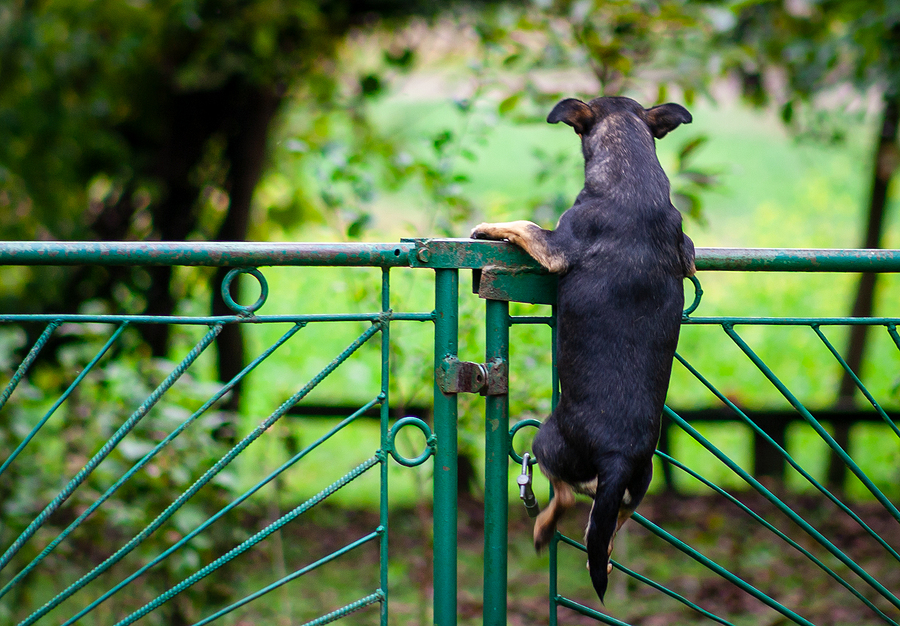I was training a client and her dog outside in her neighborhood when a scruffy dog happily approached us. There was no owner in sight. I slipped a spare leash on him and checked his collar. Luckily, “Fred” had an ID tag. I called the number.
“Hello,” I said when a woman answered. “I found a loose dog in the Vista area. I believe he’s yours; his name is Fred.”
“That can’t be my dog,” the woman snapped. “Fred is right here next to me. Fred? FRED?!”
The woman sheepishly arrived five minutes later to collect Fred, who was, indeed, hers. She had been sunbathing outside when Fred hopped the fence and went on a walkabout.
Fence jumpers are a pet parent’s nightmare. It’s frustrating when you have an escape artist, and it’s also dangerous. What if he doesn’t find his way home? What if he gets hurt or hit by a car? What if someone takes him and you never see him again?
Once a dog starts escaping a yard, it can become a habit. This is because when your dog leaves, there’s potential for a grand and rewarding adventure. He explores smells, gets into trash, chases critters, and gets attention from other people. Why should he stick around his boring backyard when the world awaits?
Containing Your Escape Artist
Keeping your Houdini hound in his yard can be tricky, depending on how he’s getting out. If it’s because someone left the gate ajar, that’s one thing. If he’s digging under or jumping over, that’s an additional challenge.
Carefully search your perimeter and make sure there are no gaps in the fence, no holes on the ground, and no objects near the fence your dog can jump on to propel himself over. Some dogs are climbers – does your fencing offer pawholds? If your dog is digging under, one option is to bury chicken wire from the bottom of the fence inwards several feet. When your dog digs, he’ll just reach wire and won’t be able to form an escape tunnel.
More importantly, create an environment your dog doesn’t want to leave. Some pet parents get hurt when their dog seems to prefer escaping to hanging out at home. Just because he escapes doesn’t mean he doesn’t love you. He’s enjoying a rewarding experience somewhere else. Your job is to create a backyard that is too enticing for him to want to leave.
Ensure he has five to six chew toys that he enjoys. Rotate them every day for a different batch. Playing with the same toys day in and out is boring. Hide frozen food-stuffed rubber toys in the yard for him to seek and enjoy.
Train your dog in your backyard, especially working on coming when called. Teach him to wait at the gate until you cue him to exit. Play games with him there so he associates the area with fun, rather than a place where he is left alone all the time. Ensure he is getting enough cardio exercise each day for his age and breed(s). Running around a yard is not enough exercise for many dogs. Consult your veterinarian if you have questions about how much exercise your dog needs.
Ideally, you can supervise your dog while he’s outside, even if it’s just checking on him through a window. Leaving a dog unattended outdoors can be risky, especially in areas where dog theft is an issue. Very small dogs should never be left unattended outdoors when large predatory birds are known to live in the area. A small dog is the same size as a rabbit, and a hawk can easily snatch one up as a snack.
Also, please ensure your dog is always wearing identification. If your dog has a microchip, please ensure the information associated with the chip is up to date. Fred’s ID tag helped me get him home quickly. His mom ended up so relieved she offered me a glass of wine as a reward! (I was working, so I declined. But still nice!)
This article was reviewed/edited by board-certified veterinary behaviorist Dr. Kenneth Martin and/or veterinary technician specialist in behavior Debbie Martin, LVT.








